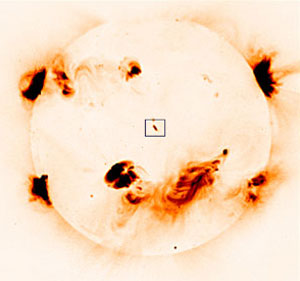Mullard Space Science Laboratory
P R E S S R E L E A S E
11th May 2005
Whimpers from the Sun?
Solar physicists have observed the smallest ever coronal mass ejection (CME) - a type of explosion where plasma from the Sun is thrown out into space, sometimes striking the Earth and damaging orbiting satellites. The observation has come as a great surprise to scientists and has turned previous ideas up-side-down.
To date studies of these phenomena have focussed on large explosions which are easier to detect and which have massive footprints on the Sun, sometimes covering thousands of millions of square miles. But in a paper published in the May edition of Astronomy and Astrophysics, an international team from the UK, Argentina, Finland, France and Hungary showed that CMEs can also be produced from regions as small as the Earth, around 10,000 miles across. This still may sound large but it is tiny by cosmic standards.
|
 |
CMEs are believed to be caused by the destabilisation of twisted loops in the Sun's magnetic field, which contain lots of energy, settling into more stable positions (like a compresssed spring being suddenly released). Until now, the events have been traced back to large areas of magnetic activity on the Sun, but the new observations relate to an area much smaller than anything seen before. However, even though the event was small it was still energetic enough to reach the Earth and amazingly the magnetic field lines were ten times more twisted than is usually seen in the larger areas.
Understanding CMEs and the mechanisms that power them is important because the plasma and accelerated particles they throw into space can damage satellites, cause harm to astronauts and even affect the Earth itself, causing beautiful aurora but also power black outs and problems to radio signals. This is the science of space weather. |
Dr Lucie Green of UCL's Mullard Space Science Laboratory said "Previously coronal mass ejections were thought to be huge, involving massive portions of the Sun's magnetic field and all the theoretical models are based around this assumption. However, this one was amazing in that it came from a tiny magnetic region on the Sun which would normally have been overlooked in the search for CME source regions. This will be an exciting area for further study."
Existing models for CMEs are based on the type of large event previously observed and the team cannot yet say how frequent such mini CMEs are or whether they represent a significant part of space weather. The event was so small that is was almost at the limit of what we can see with current instruments. Future missions studying the Sun will be able to 'see' in much better detail, such as the UK-US-Japanese mission called Solar-B.
The research used data from NASA/ESA's SOHO spacecraft, NASA's TRACE satellite and from the now defunct Japanese/US/UK Yohkoh satellite. UK involvement was funded by the Particle Physics and Astronomy Research Council (PPARC).
|
Notes to Editors:
Notes for Editors
The paper appeared in the May edition of the Astronomy and Astrophysics Journal and can be found at
http://www.edpsciences.org/papers/aa/full/2005/17/aa1079/aa1079.html
The Particle Physics and Astronomy Research Council (PPARC) is the UK's strategic science investment agency. It funds research, education and public understanding in four areas of science - particle physics, astronomy, cosmology and space science.
PPARC is government funded and provides research grants and studentships to scientists in British universities, gives researchers access to world-class facilities and funds the UK membership of international bodies such as the European Laboratory for Particle Physics (CERN), and the European Space Agency. It also contributes money for the UK telescopes overseas on La Palma, Hawaii, Australia and in Chile, the UK Astronomy Technology Centre at the Royal Observatory, Edinburgh and the MERLIN/VLBI National Facility, which includes the Lovell Telescope at Jodrell Bank observatory.
PPARC's Public Understanding of Science and Technology Awards Scheme funds both small local projects and national initiatives aimed at improving public understanding of its areas of science.
Mullard Space Science Laboratory, UCL
MSSL is situated in Holmbury St Mary between Dorking and Guildford, and is the Space and Climate Physics Department of University College London. The Group moved from London to Holmbury St Mary in 1965 after Holmbury House was purchased with funds donated by the Mullard electronics company. 150 scientists work at MSSL across 5 groups; solar and stellar physics, planetary and plasma physics, astrophysics, detector physics and climate physics. The laboratory houses world-class facilities to design, build and test instrumentation as well as analyse the data taken by the instruments in space.
Contacts
Dr Lucie Green
Mullard Space Science Laboratory
Tel: 01483 204100 (Switchboard)
Email: lmg@mssl.ucl.ac.uk
